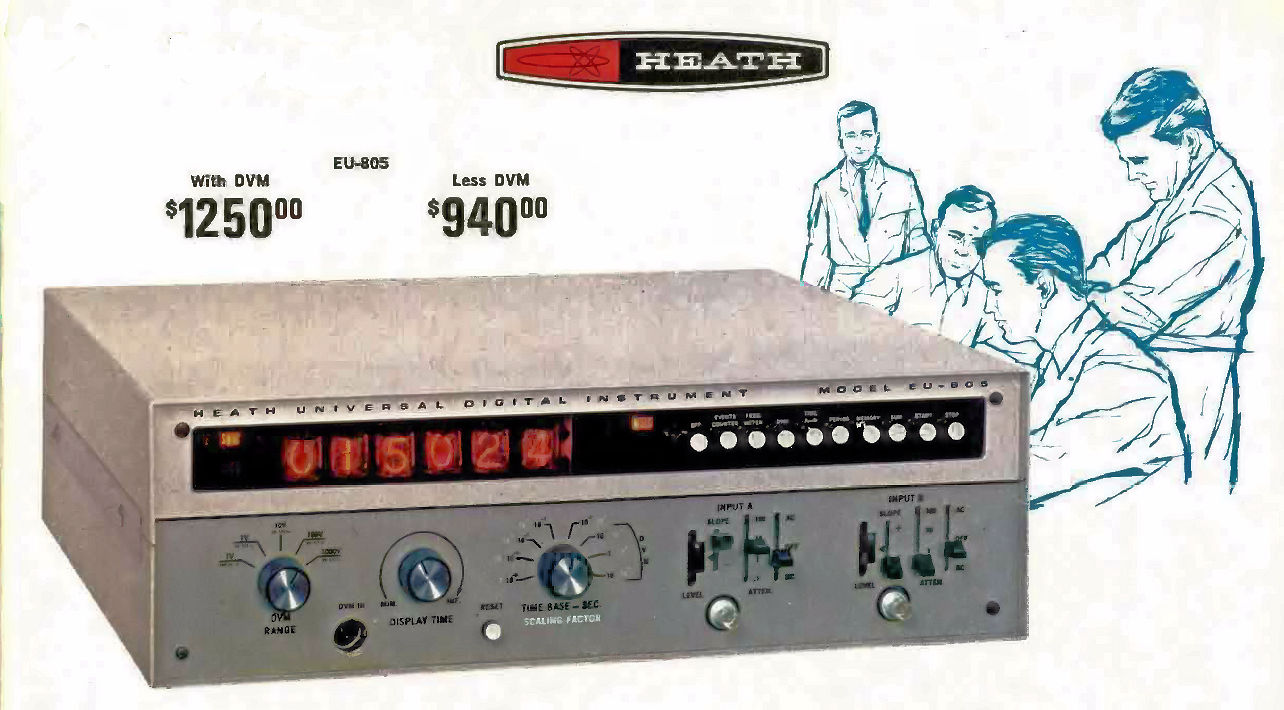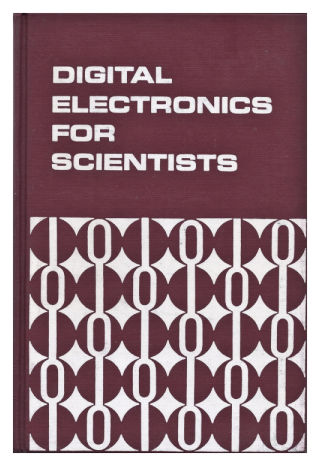Chas Gilmore joined the Heath Company in 1966 as a design engineer in the company’s Scientific Instruments group and worked at the Heath Company on and off for more than two decades, eventually becoming VP of product development, marketing, and sales. This article includes portions of an interview I conducted with Gilmore in October. It covers the heyday of pre-computer Heathkits in the 1960s and 1970s.
Steve Leibson: You joined Heath in 1966.
Chas Gilmore: I was with the Scientific Instruments group at that time. The structure of the engineering department at that time: there was a vice president of engineering, and reporting to him were, I think, six engineering section managers for amateur radio, television, audio, kit instruments, scientific instruments, and general. General did the model airplane stuff. They did all kinds of things, anything you couldn’t place in the other departments.
At that time, Scientific Instruments was a quite a new spin-off from the old kit instruments group, but the gestation of that group, what drove them to do that, was Malmstadt and Enke. You have that book, I believe. Additionally, reporting to the vice president of engineering was a Component Evaluation group (they made sure the components in a kit were from quality vendors), a Drafting group who did drawings for every part, and a Manual Department who wrote the assembly manuals and made all of the detailed exploded line drawings so the customer could see where the parts were to go.
By the time I arrived at Heath, the Manual Department was the same size as the Design Engineering departments. And the design and manual-writing efforts for a kit took approximately the same number of hours. The detailed, thoroughly checked assembly manuals were a MAJOR contributor to the success of the Heathkit products.
Steve Leibson: Yeah, Malmstadt/Enke. Yes.
Chas Gilmore: Malmstadt and Enke had approached Heath — it must have been in the ‘64 or ‘65 timeframe. They said something like, “You know, we’d like to do some fully assembled versions of your kit instruments, and also some specialized instruments, but designing and building them with the Heath mentality, not the Hewlett Packard mentality, making them very much to the 80/20 rule so we can teach electronics and electronic instrumentation to chemists.”
Malmstadt was at the University of Illinois. He was a doctoral advisor for Chris Enke, who, after getting his doctorate, was teaching at Princeton. By the time I got to Heath, Enke had left Princeton and was a professor at Michigan State in Lansing. When I joined the Scientific Instruments group in June of 1966, there were probably five of us that were engineers and there were three or four technicians, and the engineering manager, Chief Engineer Wayne Kooy.
They already had maybe a dozen instruments designed and in production. Additionally, we were venturing off into a new area because that was of great interest to Malmstadt and Enke. This was UV-visible spectroscopy. We were in the middle of the development of a modular spectroscopy system.
The core of it is a monochromator. A monochromator works as a variable wavelength or variable frequency filter for optical emissions (IR, Visible and UV). The monochromator input is a broad band of light, and the output is a selected wavelength. To do this, the monochromator used a sine bar, a grating mounted on the end of the sine bar, and an entry port with a 45-degree mirror that shot the light onto the grating, which moved under the control of a stepper motor to select variable wavelength light. There was an exit 45-degree mirror to reflect the light from the grating to the output port. In front of the monochromator, at the input side of the monochromator, you could put a number of different light sources, sample chambers, or a light source and sample chamber.
On the output side, you could put detectors—mostly photomultiplier tubes. They already had a strip-chart recorder, so you could strip-chart record the output synchronized to the monochromator wavelength position. Makes a spectrum analyzer for light. The strip-chart recorder was classic Heathkit innovation. It used a fountain pen with an ink cartridge that moved across the width of the chart paper following the input signal. This substantially lowered the cost of getting ink on the paper at some reduction in bandwidth.
A stepper motor moved the chart paper forward at controlled rates so you could plot amplitude versus time. These chart recorders cost one quarter, or less, than the cost of commercial/industrial strip-chart recorders. I remember one user saying, “I can buy multiple Heath strip-chart recorders for much less than the competitive products. If one fails I have a backup and I’m still ahead financially.”
But again, it was teaching chemists and other physical scientists how to use electronic instrumentation, including understanding the fundamentals. So, they knew Ohm’s law, how an op amp worked, what gain blocks were, and how a power supply was built, etc.
As I said, I joined in ’66. I started out as a design engineer. The first project they gave me to design was an R [resistance] box.
Steve Leibson: Well, so this leads me to an interesting question. It seems like Heath had an entire team that designed just rotary wafer switches, because they used some of the most complex rotary switches I have ever seen in my life.
Chas Gilmore: Yes, we did use complex rotary switches. And the answer is, each individual engineer would design them according to what the product being designed needed. But there were people like Centralab that built them, okay. And you built around their shaft system, their wiper system, their wafer system, etc. But an awful lot of people in the electronic world used pretty complex wafer switches. That was the control logic behind a lot of product design prior to the availability of digital integrated circuits which, in later times, were used to implement a product’s control logic.
Another product at the time was — Malmstadt and Enke wanted to create a very modular system to teach digital electronics. It consisted of a whole series of cards that you could plug into what was called a training module. At the top of the cards, there was a plastic end cap with a series of holes. The user could stick in a piece of wire and interconnect the input or output of the board’s logic function to other inputs/outputs on that card or other cards. So maybe a card had two 3-input NAND gates. Another card had some flip-flops. And you could stick wires in that connected to the input of a NAND gate and then connect the output of a NAND gate into a flip flop, etc. to breadboard circuits. Again, this system was part of the teaching system.
Then they got the idea, “You know, what would be really good is to have some of those cards such that you could plug them into the motherboard in an instrument chassis and make up a counter timer, a frequency meter, and a DMM. An engineer in that group who had been promoted from the service department was in charge of that design. I guess I had been there maybe six months, and I was just beginning to wrap up this fairly exotic R box. I had become fascinated by the new TI 7400 series of digital ICs and had been kibitzing on the digital instrument design. Anyway, my boss came to me and said, “I’m taking you off of that project. You’re gonna do the digital meter.” And so that was my first big project that went on the market a year or two later. It was 1,250 bucks. It was not an inexpensive instrument, in fact… hang on a sec, hidden away in my memorabilia section is this: that was the instrument. [holding up a photo of the EU-805 Universal Instrument].

Chas Gilmore designed the Heath EU-805 with early TTL parts from TI’s 7400 series. Image credit: Heath Company
Steve Leibson: Those are Nixie displays.
Chas Gilmore: You betcha. Those are Nixie displays. Originally, they were building the digital decade counter, latch and display driver cards using JK flip-flops and a lot of transistors. I got palsy walsy with the guys from TI, and, the next thing I knew, I had one card that drove each digit, and the card had a 7490…
Steve Leibson: Decade counter.
Chas Gilmore: A decade counter, followed by a latch, followed by a 7441, which theoretically could drive the 170 volts needed to operate the Nixie tubes.
Steve Leibson: Right. I never believed that.
Chas Gilmore: Well, I did, and I went through a lot of them before it finally got down to the point where they actually worked. The instrument functions were: frequency meter, counter/timer, and DMM. The DMM had a 0.05% accuracy. The original proposal was for a 1MHz frequency meter, and, when I got done with it, it was a 15MHz frequency meter with dual input channels so you could do AB timing, ratios, multi-source selection, etc. I must admit I got carried away, and they let me do it, and it was probably behind schedule by the time we got to the end. But that turned out to be a pretty good instrument.
An interesting story here. When I designed with the 7490, they were going for $24 in quantity. I was convinced the price would drop. When we went to market about two years later, they were $4.95. I remember breathing a deep sigh of relief. The instrument would not have been viable with six 7490s at $24 each.
We went through a number of organizational changes at that stage of the game. Heath finally decided to restructure the Scientific Instruments group and put them under a separate marketing manager or business unit manager who was going to try to promote this business. I suspect it was not a profitable product line at the time, because the market was fairly narrow, you know, this is basically training equipment for chemists. The products were supported by three textbooks. The first was: “Electronics for Scientists: Principles and Experiments for Those Who Use Instruments”; the second was…
Steve Leibson: Digital Electronics for Scientists.

“Digital Electronics for Scientists” by Malmstadt and Enke. Image credit: Heath Company
Chas Gilmore: Right. And the third was a four-book series: “Instrumentation For Scientists,” again all focused on teaching scientists the basic principles and use of electronic instrumentation. Malmstadt and Enke ran big summer seminars, but some of the higher-ups at Heath began to say, “Hey. This is not going to be a big market.”
Initially they put the Scientific Instruments business group with one of the old Heath guys as the business unit head. At that time Heath was owned by Schlumberger and had been owned by Schlumberger since 1962, I think, and this is getting into the 1972 era, or something of that nature. All of a sudden, this guy that was the marketing guy — and he, by the way, had known Howard Anthony — he was one of the early people and had been part of the audio product line, etc. But they decided that they were going to replace him with a Schlumberger hotshot. He came in at the VP level, and this other guy got retired. I think that’s the best terminology.
The new guy looked at it [Scientific Instruments] and said after a while, “You know what? We need to focus a great deal more on the general instrumentation market and kind of ease our way out of this training electronics for scientists. We’ll continue it, but it’s not going to be the big thing.” He came from Schlumberger oil well services and knew a lot about instrumentation.
In fact, we wound up selling off the spectroscopy line, because that was just too far out for Heath, at that stage of the game. Among other things, the old EU line – all model numbers for Malmstadt Enke products had a model number starting with EU – which was the educational instruments line. Those instruments were all green and white, and this guy transformed it to, I think, pretty much all white instruments.
By then I was an engineering section manager, and, all of a sudden, I assumed some product planning duties in addition to doing design engineering. We began cranking out frequency meters and function generators, strip chart recorders, quite a collection of instruments. Again, the new products were aimed at the general electronic instrumentation market rather than the training market. At Heath, the terminology was “wired.” You had, you know, kit and wired products. And Scientific Instruments was pretty much the wired products line. It began to be a reasonable product line in terms of product functionality and value.
But, all of a sudden, we’d moved from virtually not having much in the way of competition when it was the EU product line and was the Malmstadt/Enke products to all of a sudden competing with Hewlett-Packard, Wavetek, Fluke, and Keithley, and just all kinds of people out there. Systron Donner, Weston, Fairchild. Lots and lots of instrumentation people.
Steve Leibson: Tektronix.
Chas Gilmore: And without really pouring the marketing resources into getting into that market…
So somewhere around about 1975, Heath did yet another reorg, and I got moved into the product planning group, which we called product line managers, and I was handed product planning for all of the kit instrument business and all of the assembled instruments. There were also product line managers for ham radio, general, audio, and TV. Most of those guys were people who had been promoted up out of engineering but seemed to have some marketing talent. They understood the principles of a product, planning, etc, and were steeped in the product line as very dedicated hobbyists in the line they were managing. Remember that all of Heath’s sales at that stage of the game were mail orders through a catalog and a growing line of retail stores, which was kind of a separate operation.
So, that was kind of the evolution of Heath’s Scientific Instruments. At that point, like I said, we cranked out quite a few products, but it was just a tough, tough marketplace.
One of the things I came up with as a product line manager was a line of — I think they were 100-watt power supplies, where you had a 7.5 volt, a 15 volt, a 30 volt, and a 60 volt power supply, or something like that, with various ampacities constrained by the power limit and, of course, voltage and current limits. You had remote sensing, you know, and I think all the functionality that went along with a good bench power supply. There were versions with analog meters and versions with digital meters.
As kits, they did fairly well. As assembled units, what I remember was getting what I refer to as many of my master’s degrees issued by non-universities and walking down the line of inventory in the warehouse, consisting of piles of these assembled power supplies that weren’t moving because about that time, the bottom went out of the power supply market. These assembled Heath power supplies were now priced at fairly premium prices compared to, you know, Hewlett-Packard, Kepco, Lambda, and other people who were aggressively out in the market and had good sales organizations. We were trying to do it mainly with mail order and attending shows. The stores did not really address the commercial/industrial instrumentation market.
So that was a pretty good lesson that I learned fairly quickly. Then Heath reorganized again. I’m trying to think what the trigger was, but at that point I became director of engineering for what they call technical products, which was all the amateur radio, all the instrumentation, marine, automotive, weather. There were a number of those products that came under my bailiwick. Then another guy was director of engineering for the consumer products, which were the televisions, the audio, and some of the general kinds of products. And that took us into the 1976 era.
Part 3 of this article series will discuss the Heath Company’s entry into the early microcomputer/personal computer market.
Do you have Heathkit memories to share? Please post them below in the comments.
The full Heathkit history series on EEJournal:
The Rise and Fall of Heathkit – Part 1: Early Days
The Rise and Fall of Heathkit – Part 2: The 1960s through the mid-1970s
The Rise and Fall of Heathkit – Part 3: The Microcomputer Kit Era
The Rise and Fall of Heathkit – Part 4: The Demise of Heathkit
The Rise and Fall of Heathkit – Part 5: Final Thoughts
The Rise and Fall of Heathkit – Part 6: And Yet More Final Thoughts






When you’ve only seen a company from out outward facing side, it’s amazing to hear the story of what was going on inside — I can’t wait for Part 3
I got started in ham radio in the mid-70’s while in high school building Heathkit gear starting with a CW transceiver and moving on to a larger receiver and transmitter.
I hope you’re going to cover Heathkit ham radio gear in an upcoming segment.
Hi Lizardflats,
The interviews with Chas Gilmore discussed Heath’s ham radio efforts from a business perspective, but we did not discuss the actual products in any detail. Gilmore is a ham, has been since high school, so I’m certain he could discuss Heath’s ham products at length. If there’s enough interest, I can ask him to have another discussion with me. –Steve
As a ham who started in the late 60’s I would be very interested in another of your great articles with a view toward Heath ham radio efforts.